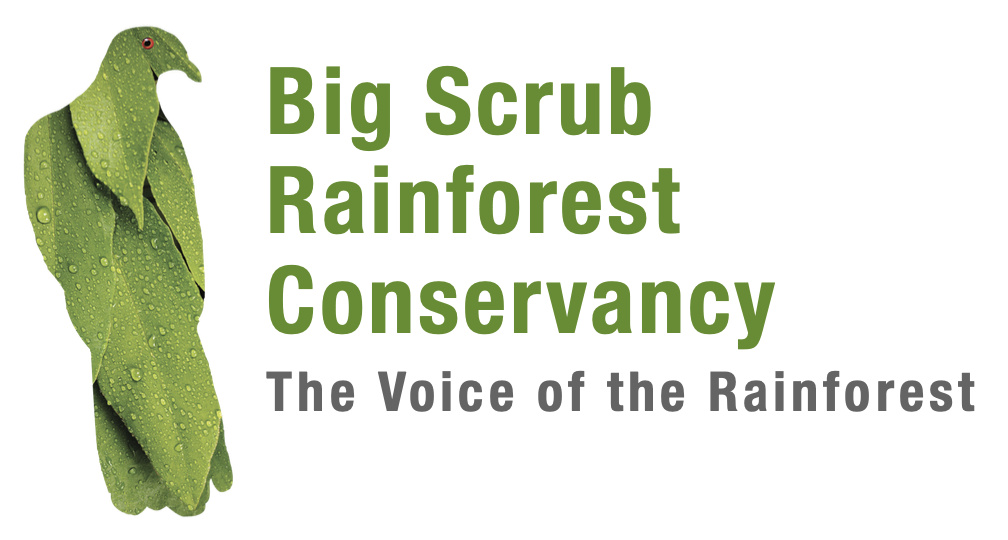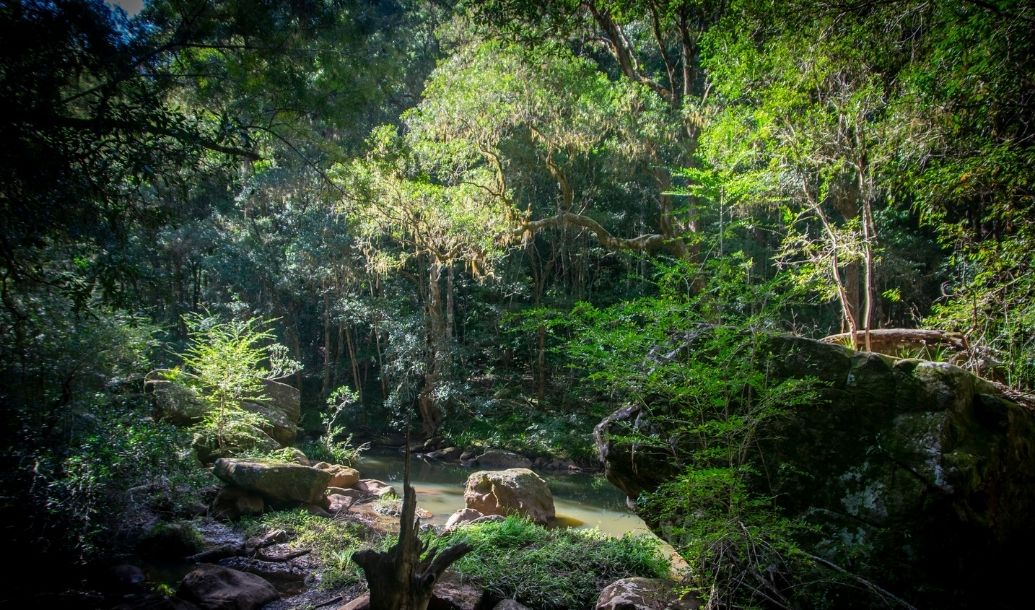Tony Parkes’ 2021-22 Annual President’s Report to the members of Big Scrub Rainforest Conservancy
After 29 years as Big Scrub Landcare, members agreed that we should change our name to Big Scrub Rainforest Conservancy (BSRC). The new name better reflects the much broader scope of our activities, particularly Science Saving Rainforests, our flagship Program.
I am pleased to report that 2021-22 continued a succession of excellent years for BSRC. We are currently running about $3 million worth of projects, an all-time record.
- The NSW Government Department of Planning and Environment has become a partner in Science Saving Rainforests (SSR) via a $478,000 contribution to a new Saving our Species (SoS) Co-Investment project to which Big Scrub Foundation will contribute $677,000 in cash. In addition, the NSW Environmental Trust has already provided grants of $308,000. Our partner Royal Botanic Garden Sydney is making substantial in-kind contributions.
- Dr Maurizio Rossetto, the Garden’s Senior Principal Research Scientist, is one Australia’s leading rainforest geneticists. He and Dr Rob Kooyman, Australia’s leading rainforest field ecologist, are actively involved in the SSR Program and are wonderful sources of scientific advice.
- The SSR Program has been expanded to include 30 threatened species and 30 key canopy and other structural species. The current funding and in-kind contributions will finance, for these 60 species, DNA sequencing, genome analyses, propagule collection, propagation of genetically optimised planting stock, the establishment of a living seed bank plantation and the establishment of a planting to demonstrate the use of genetically optimised planting stock in the restoration of critically endangered lowland subtropical rainforest and the translocation recovery of 30 of its threatened plant species.
- The collection of leaf samples for DNA sequencing is progressing well after more than 2 years of Covid 19 restrictions and flood-damaged roads that seriously impeded access to collection sites. The current schedule is for collections of leaf samples across the whole range of 23 key structural species and 8 threatened species to be completed by early 2023. DNA sequencing and genome analyses should be completed for these species by the middle of next year. Genome analyses will identify up to 20 target populations that will, for each species, provide optimal genetic diversity to avoid inbreeding depression and provide resilience to climate change, new diseases and new insects.
- Propagules (either cuttings, juveniles or seeds) of individuals of each species in each of its targeted populations will subsequently be collected and propagated into planting stock for the seed plantation that will be a living seed bank producing genetically optimised seed that will be propagated into planting stock for use in restoration plantings of critically endangered lowland subtropical rainforest and translocation recovery plantings of 30 of its threatened plant species. The project will also include a demonstration of a lowland rainforest restoration planting that will incorporate translocation recovery plantings of up to 30 threatened species.
- The methodology of our Science Saving Rainforests Program can be applied to restore other seriously degraded forest ecosystems and recover their threatened species elsewhere in Australia and around the world. The methodology can also be applied to increase the long-term sustainability of major reforestation projects and the longevity of carbon sequestration tree plantings.
- We successfully completed the major four year project under the first round of SoS Partnership Program. This $600,000 Remnant Care project focussed on the restoration of the two NSW endangered ecological communities in the Big Scrub: Lowland Rainforest in the NSW North Coast and Sydney Bioregions and Lowland Rainforest on Floodplain in the NSW North Coast Bioregion. Rehabilitation focused on the Boat Harbour Nature Reserve and 24 other very high conservation value Big Scrub remnants of these two communities.
- We also successfully completed the 14th Big Scrub restoration project funded by the NSW Environmental Trust and are now running the 15th project. These projects are continuing to make invaluable contributions to the rehabilitation of important Big Scrub remnants. Big Scrub Foundation makes indispensable contributions to the ongoing care of rehabilitated remnants by financing control of fresh weed infestations and monitoring. The cost of this ongoing care now substantially exceeds the cost of the initial rehabilitation.
- In addition to these funded projects, many of our landholder members have continued to undertake valuable restoration work on their properties.
Connecting with Community continues to be a key activity. The much-postponed Big Scrub Rainforest Day was at last held at Rocky Creek Dam on 30th October. Blessed with perfect weather, it was a huge success. Our membership has increased to more than 500 and we continue to attract more followers to our social media platforms. We are currently undertaking a major upgrade of our website.
I am pleased to report that we continue to experience good demand for the updated edition of our Restoration Manual and the Big Scrub Rainforest book.
The Big Scrub Foundation, our sister organisation, continues to make substantial financial contributions to major projects that are having a significant impact on the condition and recovery of our critically endangered lowland subtropical rainforest and its many threatened species. It contributed about $160,000 over 4 years towards the recently completed SoS Conservation Co-investment Project and is contributing about $70,000 pa to supplement the current Environmental Trust’s funding of our Remnant Care Program. In addition, the Foundation has committed to provide $677,000 to the current 4-year SoS Co-investment project that is funding our SSR Program. The Foundation’s commitment to contribute funding has undoubtedly had a major impact on our success in raising substantial government grants for our SSR and Remnant Care Programs.
I and my colleagues continue to be very excited about BSRC’s future. We are confident that we can, with the help of our partners, deliver great outcomes in our major, world-leading SSR Program.
Our Management Team is a close-knit group that continues to do a wonderful job. It currently comprises myself as President of BSRC; Renee Borrow (Manager, BSRC); Mark Dunphy (VP, BSRC); Georgie Jones (Secretary, BSRC) and Martin Brook. The team relies of the support of Pauline Roatz, our Treasurer, and former Team members Kirralee Donovan and Chris Byrne, who have full time jobs and other responsibilities but still find time to assist us. Alan Morden also provides great support in his role as Marketing and Design Advisor. I thank each of them for their contribution, particularly Renee Borrow, who has recently stepped up to the role of Manager; she is extraordinarily competent, hard-working, dedicated to our mission and a lovely person to work with.
Finally, I also record BSRC’s thanks to the many other people and organisations that contributed to our continuing success in 2021-22 particularly:
- The Big Scrub Foundation’s directors and its major donors, who are providing substantial ongoing funding for our Science Saving Rainforests and Remnant Care programs;
- Our long-term partner Envite Environment and its wonderful people: Maree Thompson, Georgie Jones and Dan Cox;
• The NSW Government’s Saving our Species unit and its Environmental Trust; - Our other project partners, supporters and collaborators including Department of Primary Industries Wollongbar, NSW National Parks and Wildlife Service, Rous County Council plus of course the many dedicated landholders with whom we work;
- Darren Bailey, Dan Cox, Jesse Vandenbosch and their teams of expert bush regenerators; and
- Our many sponsors and donors, including particularly Stone & Wood, Brookfarm, Cape Byron Distillery, the Cornell family and others who prefer to remain anonymous.
Tony Parkes AO, BSc (Hons), PhD
President


